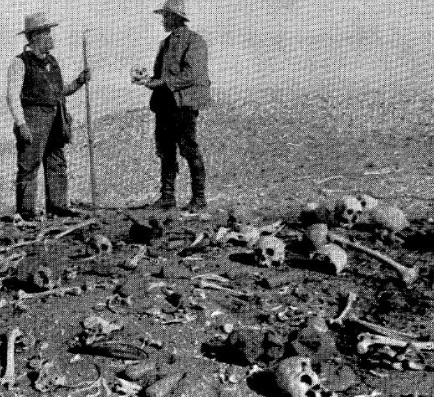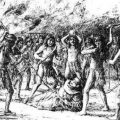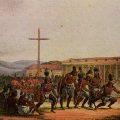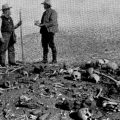
( – promoted by navajo)
What do you think of when someone says “California”?
Beaches? Sunshine? Hollywood?
How about the largest act of genocide in American history?
“The idea, strange as it may appear, never occurred to them (the Indians) that they were suffering for the great cause of civilization, which, in the natural course of things, must exterminate Indians.”
– Special Agent J. Ross Browne, Indian Affairs
[note: I was asked to cross-post this diary here.]
California was one of the last areas of the New World to be colonized.
It wasn’t until 1769 that the first mission, Mission San Diego de Alcalá, was built in California at present-day San Diego. It was the first of 21 missions, which would become the primary means for the Spaniards to subjugate the natives. The leader of this effort was Franciscan monk Junípero Serra.

Despite whatever the movies portray, the missions were coercive religious, forced labor camps. Through bribes, military intimidation, and the eventual onslaught of European diseases (that usually targeted children), the colonizers ensured that eventually sick and desperate indians would come to the missions for help.
The indians that wound up there had their children taken from them, and harsh, manual labor was the rule. Beatings and filthy living conditions were common. The death rate at the missions was appalling. By 1818 the percentage of Indians who died in the missions reached 86 percent. Over 81,000 indian “converts” eventually managed to successfully flee the missions.
Soon there were indian revolts.
The San Diego Mission was burnt down in 1775 during the Kumeyaay rebellion. Mohave Indians destroyed two mission in a dramatic revolt in 1781. Military efforts to punish these indians and reopen the route to the pueblas of New Mexico failed.
San Gabriel Mission indians revolted in 1785, and suffered because of it. The Santa Barbara and Santa Inez Missions were destroyed in the Chumash revolt of 1824. Some time after 1810 a large number of guerrilla bands arose that raided the missions and kept them in a virtual state of siege. This led to draconian laws to restrict the movement of indians and forced them to carry papers proving their employment.
In 1834, Mexican Governor Jose Figueroa freed the indians from the mission system and stripped the padres of their power. More than 100,000 indians had died because of the mission system, out of over 300,000 indians that lived in California before the Catholic church arrived.
But that didn’t mean that things returned to how it was before. The Spanish didn’t give the land back to the indians. Instead the land was distributed to political insiders, and a system of ranchos developed. By the start of the Mexican-American War, 26 million acres were controlled by just 813 ranchers.
The True Story of Sutter’s Mill

Your high school history book mentioned something about Johann Sutter, and how James Marshall, who was building a sawmill for Sutter, discovered gold on the morning of January 24, 1848. Thus forever changing the history of California, and they all lived happily ever after.
Your high school history book left out all the interesting parts.
Sutter traveled to Yerba Buena (now San Francisco) in 1839. He became a Mexican citizen in 1840, and got a land grant of 48,827 acres on June 18, 1841, that became Sutter’s Mill. The history books left off one important piece of information – there were about 200 Miwok Indians already living on that land.
Wikipedia says that Sutter “employed” indians at his mill. Tour guides at Sutter’s Mill will say the same thing today. But the written history says otherwise:
“I had to lock the Indian women and men together in a large room to prevent them from returning to their homes in the mountains at night. Large numbers deserted during the daytime.”
– Heinrich Lienhard, one of Sutter’s managers
Sutter armed Indian men from nearby villages to steal children from more distant villages and sold the captives in San Francisco to pay his debts. Another writer wrote that Sutter “was fond of the young Indian women,” implying that Sutter forced the Indian women into sexual relations.
The real situation was reflected in the testimony of one California Indian who wrote: “My grandfather was enslaved by Sutter to help in building the Fort. While he was kept there Sutter worked him hard and then fed him in troughs. As soon as he could, he escaped with his family and hid in the mountains.”
“The Indians of California make as obedient and humble slaves as the Negro in the south. For a mere trifle you can secure their services for life.”
– Pierson Reading, another of Sutter’s managers
The gold rush that followed didn’t enrich either Sutter or Marshall. Marshall was forced off his land claim by whites even more ruthless than him. In the chaos of the gold rush, almost all of the indians enslaved at Sutter’s Mill escaped, leaving no one to harvest the wheat. Sutter’s land claim was challenged in court and overturned. Sutter died in poverty.
Ironically, the chief of the Coloma Nisenan Tribe had warned Sutter beforehand, “[the gold was] very bad medicine. It belonged to a demon who devoured all who searched for it”.
Gold Rush and Genocide
“A war of extermination will continue to be waged between the two races until the Indian race becomes extinct.”
– California Governor Peter H. Burnett, January 1851

“We hope that the Government will render such aid as will enable the citizens of the north to carry on a war of extermination until the last redskin of these tribes has been killed. Extermination is no longer a question of time–the time has arrived, the work has commenced and let the first man who says treaty or peace be regarded as a traitor.”
– Yreka Herald, 1853
In 1840 only about 4,000 Europeans lived in California, only 400 of them were Americans. Now a hoard of 100,000 adventurers, gold-seekers, and murderous thugs descended on California. The authorities were completely overwhelmed. The indians faced a catastrophe of biblical proportions.
Numerous vigilante type paramilitary troops were established whose principal occupation seems to have been to kill Indians and kidnap their children. Groups such as the Humbolt Home Guard, the Eel River Minutemen and the Placer Blades among others terrorized local Indians and caused the premier 19th century historian Hubert Howe Bancroft to describe them as follows.
“The California valley cannot grace her annals with a single Indian war bordering on respectability. It can, however, boast a hundred or two of as brutal butchering, on the part of our honest miners and brave pioneers, as any area of equal extent in our republic……”
The handiwork of these well armed death squads combined with the widespread random killing of Indians by individual miners resulted in the death of 100,000 Indians in the first two years of the gold rush. A staggering loss of two thirds of the population. Nothing in American Indian history is even remotely comparable to this massive orgy of theft and mass murder. Stunned survivors now perhaps numbering fewer than 70,000 teetered near the brink of total annihilation.
The local authorities not only ignored the genocide in their midst, they encouraged it.
Rewards ranged from $5 for every severed head in Shasta City in 1855 to 25 cents for a scalp in Honey Lake in 1863. One resident of Shasta City wrote about how he remembers seeing men bringing mules to town, each laden with eight to twelve Indian heads. Other regions passed laws that called for collective punishment for the whole village for crimes committed by Indians, up to the destruction of the entire village and all of its inhabitants. These policies led to the destruction of as many as 150 Native communities.
The state of California also got involved. The government paid about $1.1 Million in 1852 to militias to hunt down and kill indians. In 1857 the California legislature allocated another $410,000 for the same purposes.
In 1856 the state of California paid 25 cents for each indian scalp. In 1860 the bounty was increased to $5.
The most famous of these massacres was the Clear Lake Massacre of 1850, in which between 80 and 400 Pomo indians were slaughtered. A marker placed there in the 1960’s which called the event “The Battle of Bloody Island” was destroyed by vandals in 2002.
To put this into perspective, around 200 indians were killed at the much more well-known Sand Creek Massacre of 1863, and just over 300 were killed in the famous Wounded Knee Massacre of 1890. Yet you would be hard pressed to find a single person living around Clear Lake today that even knew a massacre had taken place there.
The scale of the genocide in California absolutely dwarfs anything that happened to the Great Plains indians, and is even larger and more complete than the fate of the eastern indians.
The number of massacres are too numerous to list here, but a short accounting include the Bridge Gulch Massacre, the ConCow Maidu Trail of Tears, and the Wiyot Massacre, just to name a few. I don’t even have a name for the massacre of 400 Tolowa indians at the village of Yontoket in 1853, nor the massacre of hundreds more of the same tribe the following year.
What does it tell you about the state of American history in which massacres don’t even have names?
On April 22, 1850, the California government passed the Act for the Government and Protection of Indians. This law allowed for any white settler to enslave an indian child with the permission of the parents, or if the child was orphaned. Since indians weren’t allowed to testify in court against a white, this gave white settlers free reign to grab up any indian child that was found. Most didn’t even bother with the laws and just purchased them outright. To give an idea of how the authorities treated the law, consider this letter written by Indian Commissioner G.M. Hanson in 1861.
In the month of October last I apprehended three kidnappers, about 14 miles from the city of Marysville, who had nine Indian children, from three to ten years of age, which they had taken from Eel River in Humboldt County. One of the three was discharged on a writ of habeas corpus, upon the testimony of the other two, who stated that “he was not interested in the matter of taking the children:” after his discharge the two made an effort to get clear by introducing the third one as a witness, who testified that “it was an act of charity on the part of thr two to hunt up the children and then provide homes for them, because their parents had been killed, and the children would have perished with hunger.” My counsel inquired how he knew the parents had been kill? “Because,” he said, “I killed some of them myself.”
The law was later expanded to include indian adults.
According to California law, indians were forbidden to own property, carry a gun, hold office, attend public school, serve in juries, testify in court, or intermarry. On the statement of any white an Indian could be declared a vagrant and bound over to a white landowner or businessman to work for subsistence.
“But it is from these mountain tribes that white settlers draw their supplies of kidnapped children, educated as servants, and women for purposes of labor and lust…there are parties in the northern portion of the state whose sole occupation has been to steal young children and squaws …and dispose of them at handsome prices to the settlers who…willingly pay $50 or $60 for a young Digger to cook or wait upon them, or $100 for a likely young girl.”
– Marysville Appeal
In 1853 the U.S. Senate began negotiating with the indians to set up reservations. The indian tribes gladly agreed to give up millions of acres of land just to have the promise of military protection from the genocide that raged. The indians began moving to the reservation areas in anticipation.
However, the U.S. Senate refused to ratify the treaties. Instead the indians were rounded up at gunpoint to “a system of military posts”. Indians on these “reservations” were hired out to work naked as pack animals.
Each of these reservations would put into place a “system of discipline and instruction.” The cost of the troops would be “borne by the surplus produce of Indian labor.” No treaties were to be negotiated with the Indians; instead they would be “invited to assemble within these reserves.”
“The attacking party rushed upon them, blowing out their brains and splitting their heads open with tomahawks. Little children in baskets, and even babes, had their heads smashed to pieces or cut open. Mothers and infants shared the same phenomenon…. Many of the fugitives were chased or shot as they ran…. The children, scarcely able to run, toddled toward the squaws for protection, crying with fright, but were overtaken, slaughtered like wild animals and thrown into piles.”
– Alta Californian newspaper, 1860
The massacre that the Alta Californian reported, committed by a militia led by Captain W. S. Jarboe, was not only not discouraged, but on April 12, 1860 the state legislature approved $9,347.39 for “payment of the indebtedness incurred by the expedition against the Indians in the County of Mendocino.” The governor wrote a personal thank you letter to Captain Jarboe.
There were some instances of resistance on the part of the indians. The most notable was the Modoc War of 1872-73, in which 53 warriors held off held off nearly 1,000 soldiers for several months, killing 57 of the soldiers in the process.
But mostly it was a series of horrific, one-sided massacres. There were simply too many whites, in too short of period of time, that were too ruthless, against tribes of indians that were mostly peaceful.
By the mid-1860’s only 34,000 indians remained alive in California, a 90% attrition rate, comparable to the Armenian Genocide of 1915-1917. Finally, in the 1870’s, the federal government began moving on creating indian reservations in southern California. 13 were created between 1875 and 1877. By 1930 another 36 reservations had been created in northern California.



still growing but I wanted to have your words kept as a record here.
Thanks for joining and cross posting here. I would appreciate your referring other interested bloggers here also.